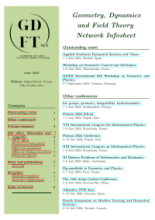The anisotropic Higgs oscillator on the two-dimensional sphere and the hyperbolic plane
An integrable generalization on the two-dimensional sphere S^2 and the hyperbolic plane H^2 of the Euclidean anisotropic oscillator Hamiltonian with "centrifugal" terms given by $H=1/2(p_1^2+p_2^2)+ \delta q_1^2+(\delta + \Omega)q_2^2 +\frac{\lambda_1}{q_1^2}+\frac{\lambda_2}{q_2^2}$ is presented. The resulting generalized Hamiltonian H_\kappa\ depends explicitly on the Gaussian curvature \kappa\ of the underlying space, in such a way that all the results here presented hold simultaneously for S^2 (\kappa>0), H^2 (\kappa<0) and E^2 (\kappa=0). Moreover, H_\kappa\ is explicitly shown to be integrable (albeit not superintegrable) for any values of the parameters \delta, \Omega, \lambda_1 and \lambda_2. Therefore, H_\kappa\ can also be interpreted as an anisotropic generalization of the curved Higgs oscillator, that is recovered as the isotropic limit \Omega = 0 of H_\kappa. Furthermore, numerical integration of some of the trajectories for H_\kappa\ are worked out and the dynamical features arising from the introduction of a curved background are highlighted. In particular we focus on the case \Omega=3\delta, whose Euclidean limit \kappa = 0 is the superintegrable 1:2 oscillator. In this case we illustrate how the Euclidean superintegrability of H is broken when the curvature \kappa\ is non-zero. Since for the specific \Omega=3\delta\ case another superintegrable curved generalization is already known in the literature, the existence of an \Omega-dependent plurality of integrable curved systems whose Euclidean limit is the same anisotropic oscillator H can be conjectured. Finally, the geometric interpretation of the curved "centrifugal" terms appearing in H_\kappa\ is also discussed in detail

